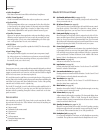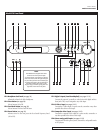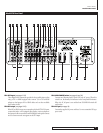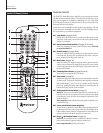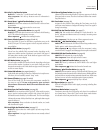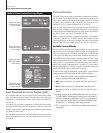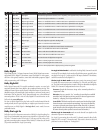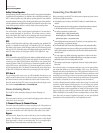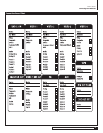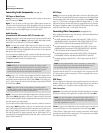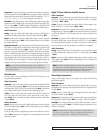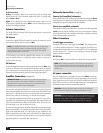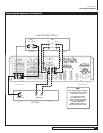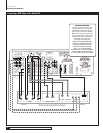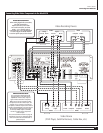
14
Outlaw Audio
Owner’s Manual
Dolby Virtual Speaker
Strictly speaking, this isn’t a surround format at all. Using advanced algorithms
(mathematical manipulations), it duplicates the sound field generated by a
full 5.1-channel speaker array with just two speakers placed as you would for
conventional stereo listening. Dolby Virtual Speaker delivers precise localization,
accurate spatial clues, and high sound quality and is ideal for anyone who wants
a surround experience without a center channel and surround speakers.
Dolby Headphone
You could call this “Dolby Virtual Speaker for Headphones” because that’s a
pretty accurate description of what it does. This circuitry creates a convinc-
ing surround effect that’s ideal for private listening with conventional stereo
headphones. The math behind it is complicated. The enjoyment isn’t.
DTS
Similar to Dolby Digital but employing a higher sampling rate, standard DTS
provides 5.1-channel surround sound. It is available on CD, DVD, laserdiscs,
PlayStation 2 video games, and D-VHS tapes. Audio-only DTS discs may be used
with any CD, DVD, or laserdisc player with a digital audio output, but DVD discs
with DTS audio must be used on players with the “DTS Digital Out” logo.
DTS-ES
DTS-ES extends the original DTS format by adding an additional back surround
channel to a soundtrack. DTS-ES-Matrix titles provide the sixth channel by
a matrix process, while DTS-ES-Discrete media deliver a true, discrete back
surround channel. Both DTS-ES formats are backward compatible with the
original DTS process, and will deliver a 5.1-channel output if your system has
no back surround speakers. The Model 970 automatically senses the presence
of either DTS-ES format and switches the processing mode when required.
DTS Neo:6
This processing mode creates up to six full-bandwidth channels from any
matrix-encoded 2-channel source. It offers two modes, Cinema and Music. Use
the Cinema mode for movie soundtracks, the Music mode for stereo music.
More info about the Model 970’s various surround-sound technologies can be
found at the
www.dtsonline.com
and
www.dolby.com
.
Stereo Listening Modes
The Model 970 offers advanced technology for stereo listening, too.
Stereo
This mode routes sound only to your front left and right speakers–and to your
subwoofer, if one is connected.
7-Channel Stereo/5-Channel Stereo
This mode routes the signal from a stereo recording to all of the speakers in
your system. There’s minimal processing so you’ll enjoy very even sound quality
as you move around the room–that’s why this is often called “party mode.”
Bypass
Like Stereo mode, Bypass also routes sound only to your front left and right
speakers. The difference between the two is that Bypass has no DSP (digital
signal processing), so there’s no surround modes, etc. As you might expect,
Bypass delivers a somewhat cleaner sound than Stereo mode.
Connecting Your Model 970
Before connecting your Model 970 to other system components, please observe
the following simple precautions:
Don’t plug the power cord into your Model 970 until you’ve made all other con-
nections.
Always pay attention to the warnings, options, and specific procedures contained
in the instructions that came with the component you’re connecting.
For analog connections, remember that:
red input jacks = right channel audio
white input jacks = left channel audio
yellow input jacks = composite video
Insert all plugs and connectors securely. If you don’t, you may experience noise,
poor performance, or equipment damage.
Don’t bundle audio/video connection cables with power cords and speaker cables.
To get the performance you expect, run all the power cords down one side of the
cabinet, all the signal connections down the other side, and the speaker cables
down the center.
You may want to use digital and analog connections to and from the same
component. This will give you additional flexibility as you configure your system,
particularly when you use an analog audio recorder.
When using an optical input or output jack, always use a high-quality optical
fiber cable.
Given the wide variety of components and many ways you can connect them,
you might find initial set-up a bit intimidating. Don’t worry. The following
diagrams will guide you through the maze. They graph some of the more com-
mon situations you might encounter. Rest assured, however, that there would
most likely be several ways to connect a component so these diagrams are not
hard and fast blueprints. (Please remember to consult the owner's manual that
came with the component you are connecting for more information.)
In order to alleviate potential confusion, use the chart on page 15 to record each
connection (which output to which input, etc.) as you connect your system’s
components. These connections might change as you get further into your
system configuration and we suggest that you make a few photocopies of that
page (or print a few copies of the page from the PDF version of this manual,
which is available from our website) to use as worksheets before you start. When
you’re done and your system is functioning properly, you can enter the final
connections into the manual itself for a more permanent record.
Stereo Listening Modes



